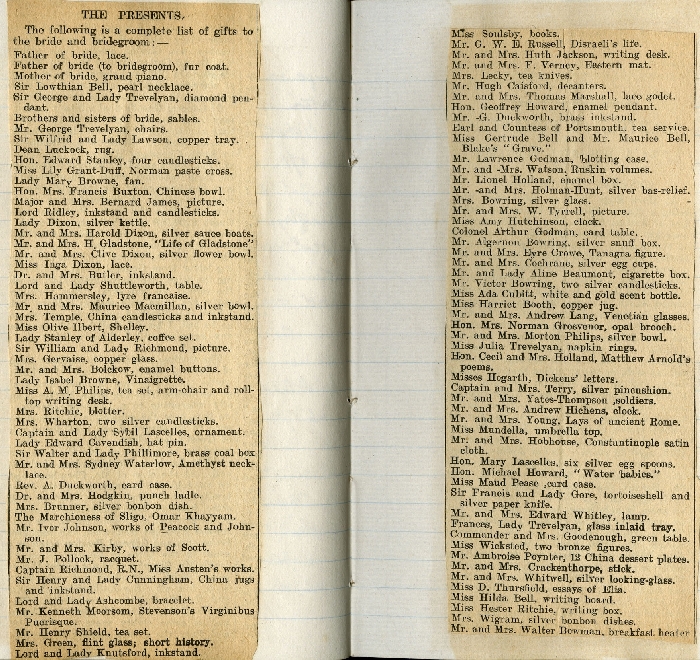
To celebrate the Royal wedding of Prince William and Kate Middleton on Friday 29th April 2011 we bring you a special ‘wedding’ treasure!
The postcard photograph above shows Mr. and Mrs. Charles Trevelyan with the Trevelyan family crest, which bears the motto ‘Time tests faith’. Charles Philips Trevelyan (1870 – 1958) married Mary Bell (1881 – 1966), the half sister of Gertrude Bell, in 1904. Special Collections holds Charles’ papers, the Liberal MP who famously defected to Labour in 1918. It is unknown what this postcard was used for. It dates from after their wedding in 1904 as they are identified as ‘Mr and Mrs Trevelyan’. It may have been part of a thank you note to guests for their wedding presents or simply a portrait of the newly-married couple that they sent out to family and friends.
Special Collections also holds the papers of Mary Trevelyan (who was known as Molly), including her diaries for the years 1892 – 1917. The page below is taken from her diary for 1904 and is among a series of entries regarding their wedding day.

They include her handwritten account of the wedding day with cuttings from the press and a complete list of gifts received by the bride and bridegroom.
This page shows one of three cut-out from the newspaper listing all the wedding presents they received and who they were from.
The fact that this was published in the press shows that the public appetite for information about the rich and famous has always been strong!
Gifts included a grand piano from the mother of the bride; a fur coat from the father of the bride to the groom; numerous collections of books and poems, including The Life of Gladstone from Mr and Mrs Gladstone; some letters written by Dickens; tea sets; writing desks; two grandfather clocks; hundreds of items of silverware; and more candlesticks and inkstands than anyone could ever find occasion to use!
Wedding presents have been given since ancient times. They have normally been practical items for the new couple’s home. However, in some cultures guests would have been expected to contribute to the wedding banquet as a thank you for their invitation! The idea of the wedding trousseau or ‘bottom-drawer’ put together by the bride’s family has its origins in the dowry. Dowry is an ancient custom, which has been practised around the world throughout history. This has often been money but can also include a selection of goods paid for by the bride’s family to furnish the newlywed’s home. As many newlywed couples did not have much money, the bride’s mother would put away household goods, including homemade items often in a bottom drawer, starting before their daughters had even met their future husband! The idea was to create a collection of everything a young woman setting-up her first home would need. Some ostentatious Victorians even introduced a ‘trousseau tea’ in an effort to out-do each other, where wealthy families would display trunk loads of linens, china and clothes they had put together for their daughters!
Nowadays, as many couples live together before marriage, wedding gift lists are more likely to include luxury items rather than practical ones and many couples choose not to have traditional gifts at all, instead asking guests to contribute money to a honeymoon, they could perhaps not otherwise afford. Prince William and his bride-to-be Kate Middleton have asked guests to donate money to charity rather than buy them wedding presents. This is likely to lead to hundreds of thousands of pounds being donated to the twenty-six, not very well-known, charities that the couple have chosen. Of course there are some advantages – they are less likely to end up with things they do not need. The Queen and Prince Philip received five hundred cases of tinned pineapple and ingredients for their wedding cake from the Australian people when they married in 1947. However, William and Kate they are still likely to receive numerous presents from the general public. Prince Charles and Princess Diana received thousands of presents from well-wishers around the world after their marriage at St Paul’s Cathedral in 1981, including a roomful of antique furniture from Canada and twenty silver platters inscribed with their wedding date from Australia. A selection of the presents was placed on display at St. James’s Palace and some items were later distributed to charity. After all there are only so many toasters and kettles that a Royal couple needs!
